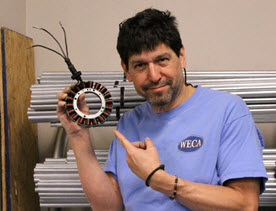What goes up must come down, or does it?

By Jimmie Slemp, WECA Instructor and Lab Manager
My niece had the misfortune of needing a new water heater. She really wanted to go with a "tankless" system. Unfortunately, the neighborhood that she lives in does not have natural gas service. It also turns out the electrical requirements for an electric tankless system are expensive, so she opted for a replacement water heater similar to her old one.
So off to the big box store we go. Luckily my niece is practical and only wanted a comparable replacement. I on the other hand started to over think it while looking at all the choices.
Most of the larger water heaters have two heating elements (upper and lower), and as I looked at the wattage ratings of the heating elements, I found myself unsure if I needed to add the two ratings together to get the total load.
Well, when in doubt read the directions. So I started looking for anything on the boxes or any literature laying around that would help me determine what the total load would be. At this point it must have been obvious that I needed some help because a store employee asked me, "Can I help you?" (Something that rarely happens when I actually need help in a store!) So I posed the question, "Do I have to add the two elements together to get the total load?" And the answer given, with a slight hesitation was a yes.
I did not believe him, especially with his hesitant answer. Now my mind was starting to go into overdrive and I couldn't believe I was struggling with a simple water heater. I saw myself in my own classroom telling myself, "It's easy, don't over think it." I decided to do a quick calculation - 4500 watts (x2 elements) = 9000 watts divided by 240 volts = 37.5 amps. A typical electric water heater is considered a continuous load so 37.5 amps (x 125%) = 46.875 amps.
That was easy enough except every common tract house with an electric water heater has a 240 volt / 30 amp circuit. So I quickly did the same calculation simply using 4500 watts by itself (4500 watts / 240 volts = 18.75 amps x 125% = 23.43 amps) now that sounds like a good fit for a 30 amp circuit.
This is where I finally found my peace of mind, not it the calculation, but in a wiring diagram I found on the back of the owner's manual. It showed that the power switched between the two elements and that only one element could be on at a time. In the drawing, terminal 1 is common and switches between terminals 2 and 4 (the upper and lower elements).

Now everything is good and my niece has picked out a water heater. We are finalizing the purchase with another employee--when I happen to mention that the previous employee may have been mistaken in answering my question. This person proceeded to tell me about electrical circuits and that as the voltage goes up the current goes down - or does it? The only thing I find worse than my previous lack of confidence, is someone else that is confident in their lack of knowledge.
For example, in a basic resistive circuit such as an electric water heater, when the voltage goes up; the current goes up. It seems fifteen minutes ago I couldn't figure out the load of a water heater - now I was enlightening this employee on the basics of ohms law. I politely told him that in a basic circuit, voltage and current were proportional and that when voltage goes up so does current.
So if a dual voltage (240/208) electric water heater has an element rated at 4500 watts @ 240 volts - how many watts will it produce at the lower 208 volts?
As we can see by the name plate, an electric water heater will produce less wattage at a lower voltage.
This is because a water heater uses a resistive element. In this case the element has a resistance of approx. 12.8 ohms. The lower the force behind the electrons (voltage) the lower the flow of electrons (current) 208 volts / 12.8 ohms = 16.25 amps. Power (wattage) is a result of voltage x current 208 volts x 16.25 amps = 3380 watts.